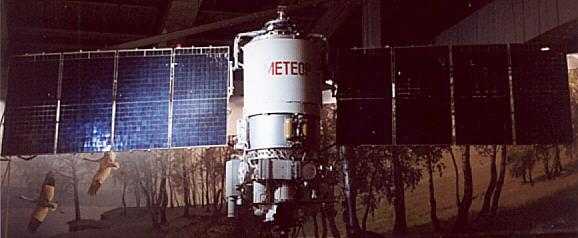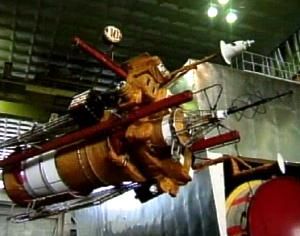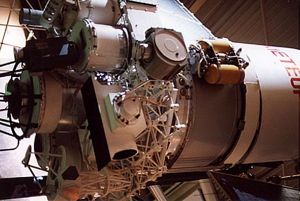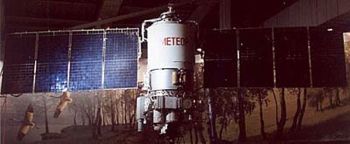
Home - Search - Browse - Alphabetic Index: 0- 1- 2- 3- 4- 5- 6- 7- 8- 9
A- B- C- D- E- F- G- H- I- J- K- L- M- N- O- P- Q- R- S- T- U- V- W- X- Y- Z
Meteor-3

Meteor 3
Meteor 3 exhibited at Hannover Expo 2000.
Credit: © Mark Wade
AKA: 17F45. Status: Operational 1984. First Launch: 1984-11-27. Last Launch: 1994-01-25. Number: 7 . Gross mass: 2,150 kg (4,730 lb). Height: 6.50 m (21.30 ft). Span: 12.70 m (41.60 ft).
It underwent an incredibly difficult and protracted development, not flying until the 1990's.
Flight trials of Meteor-2 began reasonably well, but delays were encountered due to the technological base at VNIIEM and Istra. Therefore a resolution of 4 June 1970 ordered VNIIEM to develop a parallel design of another meteosat for the hydrology office alone. This was not put into production. In its place a resolution of 16 December 1972 ordered design of a third generation system. This used the Planeta-S sensor package in the non-co-orbital Meteor-3 system plus the geostationary system Elektro. A 1981 resolution called for a Planeta unified meteorological system. Development of the third generation Meteor was not funded until June 1983. The draft project was completed in 1984 by VNIIEM Filial Istriisk under V I Adasko. Tests of some new equipment aboard modified Meteor-2 vehicles began at the end of 1984. Flight trials of Meteor-3 also began in 1984, but the first complete spacecraft only flew in 1990. The last Meteor 3 was scheduled for 1995 but was never launched due to funding problems. It was to be followed in 1996 by the first of the Meteor 3M class, which was finally put into orbit in 2001.
According to documents filed with the World Meteorological Organization, the objectives of the Meteor 3 program were:
- to obtain, on a regular basis, global data on the distribution of cloud, snow, and ice cover and surface radiation temperatures once or twice daily at times close to the synoptic times
- to obtain, on a regular basis, regional data on the distribution of cloud, snow, and ice cover
- to obtain, during each communication session, global data on the vertical temperature and humidity distributions in the atmosphere
- to observe, on a regular basis, information on radiation conditions in near-Earth space globally once or twice a day, and for each orbit in storm conditions
To eliminate low latitude coverage gaps, the altitude of Meteor 3 satellites was increased 250 km in comparison with the Meteor 2 network, i.e., approximately 1,200 km circular orbits with an inclination of 82.5 degrees. The higher altitude provided a wider ground swath for the same instrument angular field-of-view. All Meteor 3 spacecraft were launched by the Tsyklon-3 booster from the Plesetsk Cosmodrome.
Although very similar to its predecessor, the Meteor 3 satellite incorporated several new improvements and capabilities. Total spacecraft mass was 2,150-2,250 kg with a payload of 500-700 kg in a volume of 0.7 m3. The spacecraft was essentially a vertically oriented cylinder with a maximum diameter of slightly more than 1 m and a height of about 1.5 m which supported a payload equipment truss at the bottom, a gravity gradient stabilization system on top, and two movable solar arrays (1.5 m tall by 3.5 m wide). The spacecraft bus was maintained at standard temperatures and pressures and was fed a total output power from the solar arrays of 500 W. The design lifetime was two years.
Meteor-3 could also be 3-axis stabilized using cold gas thrusters. Pointing accuracy in this mode was 20 arc-minutes. The payload truss was an innovation compared to the Meteor 2 satellite design and facilitated the addition of new and experimental instruments. The principal telephotometer produced an image size of 195 mm by 290 mm. This was scanned at 3.8 lines per mm with at least 12 grey levels. Swath width 3100 km; resolution 0.8 x 1.5 km. Similarly, the IR radiometer image of 148 mm by 290 mm was scanned at 1 line per mm with at least 9 grey levels. The 10 channel spectrometer included one band for water vapor, six bands for carbon dioxide, one band for ozone, and two bands at about 11 micrometers. The experimental Ozon-M spectrometer was designed to measure total ozone content and vertical ozone distribution in individual regions . In addition to 137-138 MHz direct transmissions, data was also beamed to Earth at 466.5 MHz (FM, plus or minus 120 KHz bandwidth, 10 W output power) in a "store and forward" mode. The primary ground stations were located at Moscow/Obninsk, Novosibirsk, and Khabarovsk.
More at: Meteor-3.
Family: Earth, Earth weathersat, Medium earth orbit. Country: Russia. Launch Vehicles: Tsiklon, Tsiklon-3. Launch Sites: Plesetsk, Plesetsk LC32/1, Plesetsk LC32. Agency: MO, VNIIEM. Bibliography: 102, 115, 2, 445, 6, 12826.
 | Meteor-2 Credit: Ukrainian Space Agency |
 | Meteor 3 Detail Instrument package of Meteor 3 exhibited at Hannover Expo 2000. Credit: © Mark Wade |
 | Cosmos 1960 Credit: Manufacturer Image |
1972 December 16 - .
- Elektro, Meteor-3 weather satellites authorised - .
Nation: Russia.
Spacecraft: Elektro,
Meteor-3.
Military-Industrial Commission (VPK) Decree 'On establishment of the Planeta-S weather satellite system' was issued. The resolution ordered development of a third generation system. This used the Planeta-S sensor package in the non-co-orbital Meteor-3 system plus the geostationary system Elektro, which was to begin tests in 1982. Elektro suffered numerous delays due to equipment and software problems. Flight trials of Meteor-3 did not begin until 1984, and there was only a single launch of Elektro, in 1994.
1984 November 27 - . 14:12 GMT - . Launch Site: Plesetsk. Launch Complex: Plesetsk LC32/1. LV Family: R-36. Launch Vehicle: Tsiklon-3. FAILURE: Stage 3 failed to reignite.. Failed Stage: 3.
- Cosmos 1612 - . Payload: Meteor-3 s/n 1. Mass: 2,150 kg (4,730 lb). Nation: Russia. Agency: MO. Class: Earth. Type: Weather satellite. Spacecraft Bus: Meteor. Spacecraft: Meteor-3. Decay Date: 1984-12-31 . USAF Sat Cat: 15406 . COSPAR: 1984-120A. Apogee: 1,227 km (762 mi). Perigee: 132 km (82 mi). Inclination: 82.60 deg. Period: 98.30 min. Unusable orbit, however the operator was able to operate the satellite in a limited manner. First launch of new Meteor-3 spacecraft..
1985 October 24 - . 02:30 GMT - . Launch Site: Plesetsk. Launch Complex: Plesetsk LC32. Launch Pad: LC32/1. LV Family: R-36. Launch Vehicle: Tsiklon-3.
- Meteor 3-01 - . Payload: Meteor-3 s/n 2. Mass: 2,150 kg (4,730 lb). Nation: Russia. Agency: MO. Class: Earth. Type: Weather satellite. Spacecraft Bus: Meteor. Spacecraft: Meteor-3. USAF Sat Cat: 16191 . COSPAR: 1985-100A. Apogee: 1,210 km (750 mi). Perigee: 1,182 km (734 mi). Inclination: 82.60 deg. Period: 109.30 min. First successful launch of new Meteor-3 spacecraft. Further improvement of the meteorological system using artificial earth satellite, including development of informational and measurement apparatus and remote sensing methods..
1988 July 26 - . 05:01 GMT - . Launch Site: Plesetsk. Launch Complex: Plesetsk LC32. Launch Pad: LC32/2. LV Family: R-36. Launch Vehicle: Tsiklon-3.
- Meteor 3-02 - . Payload: Meteor-3 s/n 3. Mass: 2,150 kg (4,730 lb). Nation: Russia. Agency: MO. Class: Earth. Type: Weather satellite. Spacecraft Bus: Meteor. Spacecraft: Meteor-3. USAF Sat Cat: 19336 . COSPAR: 1988-064A. Apogee: 1,210 km (750 mi). Perigee: 1,182 km (734 mi). Inclination: 82.50 deg. Period: 109.30 min. Continued improvement of the meteorological system using artificial earth satellites, including the testing of information-gathering and measuring apparatus and of remote sensing methods. .
1989 October 24 - . 21:35 GMT - . Launch Site: Plesetsk. Launch Complex: Plesetsk LC32. Launch Pad: LC32/1. LV Family: R-36. Launch Vehicle: Tsiklon-3.
- Meteor 3-03 - . Payload: Meteor-3 s/n 4. Mass: 2,150 kg (4,730 lb). Nation: Russia. Agency: MO. Class: Earth. Type: Weather satellite. Spacecraft Bus: Meteor. Spacecraft: Meteor-3. USAF Sat Cat: 20305 . COSPAR: 1989-086A. Apogee: 1,249 km (776 mi). Perigee: 1,240 km (770 mi). Inclination: 82.60 deg. Period: 110.40 min. Testing data-measuring equipment and methods for remote sensing of the atmosphere and Earth's surface to benefit the Soviet economy and science. .
1991 April 24 - . 01:37 GMT - . Launch Site: Plesetsk. Launch Complex: Plesetsk LC32. Launch Pad: LC32/2. LV Family: R-36. Launch Vehicle: Tsiklon-3.
- Meteor 3-04 - . Payload: Meteor-3 s/n 6. Mass: 2,150 kg (4,730 lb). Nation: Russia. Agency: MO. Class: Earth. Type: Weather satellite. Spacecraft Bus: Meteor. Spacecraft: Meteor-3. USAF Sat Cat: 21232 . COSPAR: 1991-030A. Apogee: 1,209 km (751 mi). Perigee: 1,187 km (737 mi). Inclination: 82.50 deg. Period: 109.40 min. Testing data-measuring equipment and methods for remote sensing of the atmosphere and Earth's surface to benefit the Soviet economy and science. First completely operational version of the spacecraft..
1991 August 15 - . 09:14 GMT - . Launch Site: Plesetsk. Launch Complex: Plesetsk LC32. Launch Pad: LC32/2. LV Family: R-36. Launch Vehicle: Tsiklon-3.
- Meteor 3-05 - .
Payload: Meteor-3 s/n 5/TOMS. Mass: 2,150 kg (4,730 lb). Nation: Russia.
Agency: GMS.
Class: Earth.
Type: Weather satellite. Spacecraft Bus: Meteor.
Spacecraft: Meteor-3.
USAF Sat Cat: 21655 . COSPAR: 1991-056A. Apogee: 1,208 km (750 mi). Perigee: 1,185 km (736 mi). Inclination: 82.60 deg. Period: 109.30 min.
Gathering of hydrometeorological data; testing of data-gathering and measuring equipment, of optical and mechanical television and radiometric scanning apparatus, of instruments for geophysical research and of methods for the remote sensing of the atmosph ere and the Earth's surface for various branches of the USSR economy and science; charting the state of the ozone layer, using American (Total Ozone Mapping Spectrometer) instrument. Meteor 3-5 continued to operate during 1993-1994, but its US TOMS developed problems in May, 1993, and failed entirely in late 1994. However, the data returned by the 30-kg instrument, particularly over the south polar region, was exceptionally valuable.
1994 January 25 - . 00:25 GMT - . Launch Site: Plesetsk. LV Family: R-36. Launch Vehicle: Tsiklon-3.
- Meteor 3-06 - .
Payload: Meteor-3 s/n 7. Mass: 2,150 kg (4,730 lb). Nation: Russia.
Agency: RAKA.
Class: Earth.
Type: Weather satellite. Spacecraft Bus: Meteor.
Spacecraft: Meteor-3.
USAF Sat Cat: 22969 . COSPAR: 1994-003A. Apogee: 1,228 km (763 mi). Perigee: 1,191 km (740 mi). Inclination: 82.00 deg. Period: 109.40 min.
Obtained meterological and solar-terrestrial data. Meteor 3-6 was inserted into an orbital plane 60 degrees to the west of Meteor 3-5's plane and ejected the small German satellite Tubsat B on the second orbit. Meteor 3-6 also carried an integrated French radiometer called SCARAB (Scanner for Radiation Budget) and a German PRARE (Precision Range and Range Rate Experiment) geodetic instrument. The French radiometer was designed to study the Earth's radiation budget over an extended period of time and to measure the effect of clouds on the greenhouse phenomenon. A second SCARAB instrument was manifested on a Meteor spacecraft that was to be launched in 1996, but this did not come to pass. The German PRARE was similar to the instrument carried on ESA's ERS· 1 satellite.
Back to top of page
Home - Search - Browse - Alphabetic Index: 0- 1- 2- 3- 4- 5- 6- 7- 8- 9
A- B- C- D- E- F- G- H- I- J- K- L- M- N- O- P- Q- R- S- T- U- V- W- X- Y- Z
© 1997-2019 Mark Wade - Contact
© / Conditions for Use